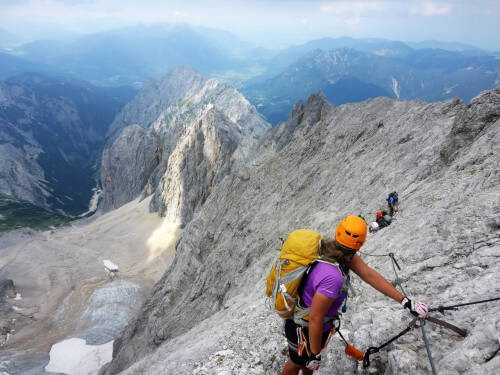

Difficulty Ratings
At Alpenventures UNGUIDED, we have tours to fit every skill level, and that are suitable for varying fitness levels. Below is the description of our various difficulty ratings. Please keep in mind that our customers come to us from all over the world with a variety of hiking backgrounds and fitness levels. We are not able to assess how the difficulty will be for you. Everyone must determine this for themselves. We provide plenty of tools to enable you to do so.
For each tour, an overall difficulty rating is given related to physical condition and to technical difficulty under normal conditions. There are then more specific difficulty ratings, such as Hiking Difficulty (HD) and Via Ferrata Difficulty that will vary from segment to segment in an itinerary. Doing a tour in the shoulder season, or in poor weather conditions, may alter the difficulty of the tour.
Difficulty ratings are highly subjective, and each individual has their own comfort level. The difficulty ratings provided for your segments are created by people who hike in the Alps for people who hike in the Alps, and apply to normal conditions. If you are not used to hiking in a rugged mountain environment, everything will likely feel more difficult to you.


There is always a possibility that certain conditions may present unexpected challenges on the tours. Some examples include snowfields on an early-season hut hiking tour, an unexpected dump of snow, flooding, landslides, or rock-fall on a via ferrata tour. It is important to understand the risks beforehand by reading the Safety Briefing for the tour (this is located on the Documents tab on each individual tour page). Tour participants should always be prepared to deal with unexpected difficulties.
More detailed daily statistics, such as distance and elevation gain, are included under the Itinerary tab on each individual tour page. Daily elevation gain is the most important factor when assessing the difficulty of a tour for yourself. Details regarding technical difficulty on a tour are included under the Skills and Experience Required tab, as well as the Safety Briefing under the Documents tab for that tour. We also include photos, and often videos, to allow you to assess the difficulty of a tour yourself.
Technical Difficulty
For each of our tours, we provide a general Technical Difficulty rating for the overall tour for your quick reference. Individual segments receive a more detailed technical difficulty rating (see Hiking Difficulty and Via Ferratas below). Keep in mind that these ratings are for alpine terrain. If you are not used to traveling through alpine terrain, they may feel more difficult to you than described.
Low: This tour presents few technical challenges and can be completed without special knowledge and training*
Middle: Knowledge and training are required in the corresponding activity for this tour. Please check the Skills and Experience Required in the Tour Description for more information
High: This tour presents significant technical difficulty and extensive knowledge and training are required in the corresponding activity for this tour. Please check the Skills and Experienced Required in the Tour Description for more information
*Navigation skills, an ability to judge weather conditions and the ability to pack the right equipment are considered basic knowledge and are required for every Alpenventures UNGUIDED tour
Hiking Difficulty (HD)
The Hiking Difficulty (HD) uses a scale that we apply to individual segments on a tour. It begins with a T (T1, T2, T3, etc.) and represents the technical difficulty of the hiking trail. We use the SAC (Swiss Alpine Club) hiking difficulty scale. This is very helpful in letting you know when you may encounter some exposure, excessively steep terrain, or sections requiring route finding or that have more challenging navigation. If the most difficult section on a segment is T3, then we will assign a T3 difficulty to the entire segment, even if the T3 section is only a few meters.
Remember that a trail that is rated easy, T1, can unexpectedly turn into a T3 or worse when covered in snow or after flooding or a landslide.
T0
This is not part of the SAC Hiking Difficulty Scale. If you see this, it means the path is considered a walking path and not a hiking trail. It could be a standard pathway through a village or a walk along a road.
T1
Easy hiking path - wide, continuously visible path. There is no danger of falling assuming normal behavior. This is often a gravel road.
T2
Hiking trail - sometimes steep or narrow. Danger of falling cannot be ruled out. Basic surefootedness and orientation skills are an advantage. This can be considered a standard hiking trail in the Alps and will be comfortable for most hikers.
T3
Mountain hiking trail - may contain chain-secured and exposed sections. The path is not always visible. Sometimes you need your hands for balance. Sure-footedness and average orientation skills are required. T3 is usually found only in short stretches. These stretches are uncomfortable, although doable, for most hikers. Hikers with extreme fear of heights may struggle here. Due to the rugged nature of the terrain in the Alps, it is nearly impossible to find a multi-day hiking stretch in the Alps that does not include at least a handful of these sections.
T4
Alpine hiking trail in harsh, steep terrain - there may be easy climbing sections (I UIAA), steep grassy slopes, scree, easy snowfields and glacier passages. Often pathless terrain with exposed sections and the risk of falling. These trails are rarely included in Alpenventures trekking itineraries.
T5
Harsh, steep terrain - there may be easy climbing passages (I - II UIAA), very steep grassy slopes, sometimes with rocky outcroppings, steep snowfields and glacier passages. Usually pathless, exposed terrain, with the risk of falling over extended stretches. These trails are generally not included in Alpenventures trekking itineraries.
T6
Extremely steep terrain - this may include long climbing sections (II - III UIAA), extremely steep grassy slopes, steep snowfields and glacier passages. Usually pathless, very exposed terrain, with an increased risk of falling over extended stretches. These trails are generally not included in Alpenventures trekking itineraries.
Physical Condition
The Phyiscal Condition ratings are based on a difficulty rating scale applied by the German Alpine Club (DAV). That means these ratings are for hikers who regularly travel through alpine terrain. If you are not used to traveling in such terrain, these ratings may not represent your capability.
Keep in mind that difficulty ratings are extremely subjective. The best way to assess the difficulty level of a tour is by looking at the Itinerary Tab for that tour and examining the daily distance, elevation gain and loss. The emphasis should be on elevation gain. Compare this to other tours you have done and this will give you the most accurate assessment of how difficult this tour will feel for you.
Activities by Foot (Trekking and Via Ferratas)
Low: Capable of up to 5 hours of the corresponding activity per day and 610 meters/2,000 feet of elevation gain
Middle: Capable of up to 8 hours of the corresponding activity per day and 1,220 meters/4,000 feet of elevation gain
High: Capable of more than 8 hours of the corresponding activity per day and more than 1,220 meters/4,000 feet of elevation gain
Bicycle Touring
Low: Capable of up to 50 kilometers/31 miles per day and 500 meters/1,640 feet of elevation gain per day
Middle: Capable of up to 80 kilometers/50 miles and 800 meters/2,625 feet of elevation gain per day
High: Capable of more than 80 kilometers/50 miles and more than 800 meters/2,625 feet of elevation gain per day
Via Ferratas
There are many different scales that are used to rate via ferrata difficulty. At Alpenventures UNGUIDED, we used the Schall Scale, which is the standard in Austria.


For additional information on via ferrata difficulty ratings, and comparison of the various scales, please refer to our All About Via Ferratas page.
